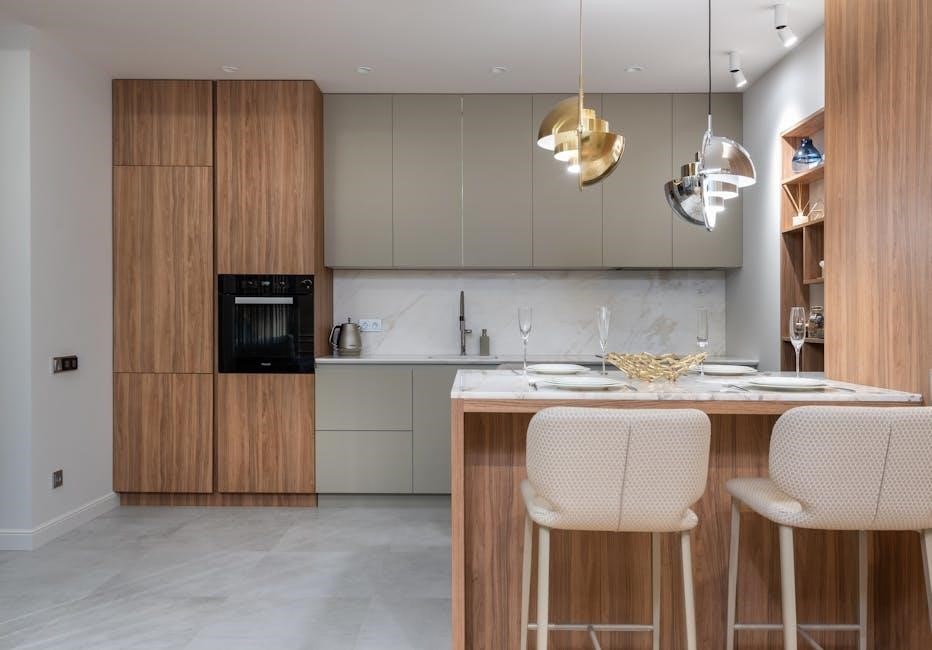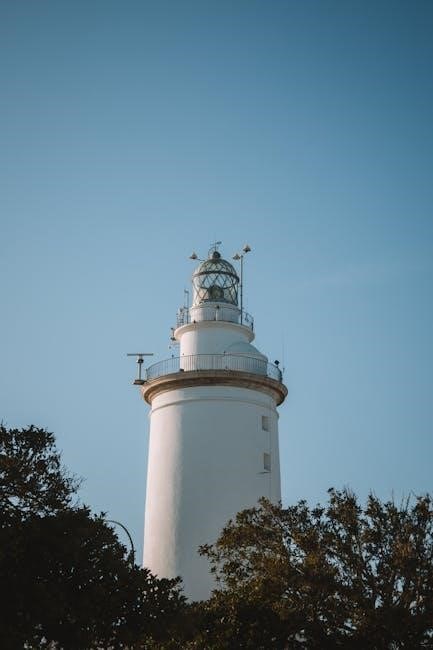A Light Guide Plate (LGP) is a critical optical component designed to evenly distribute light from LEDs across surfaces, enhancing visibility and aesthetics in displays and lighting systems.
Definition and Basic Function
A Light Guide Plate (LGP) is an optical component designed to distribute light evenly across a surface, enhancing visibility and aesthetics. It is typically used in backlit displays, LED lighting, and signage. The LGP works by channeling light from LEDs through its surface, ensuring uniform illumination. Its basic function involves capturing light from one or more edges and redirecting it through a pattern of microstructures or dots, which scatter the light across the plate. This creates a smooth, even glow without hotspots. The LGP is crucial for applications requiring consistent light distribution, making it a fundamental element in modern display and lighting technologies. Its optical clarity and efficiency make it indispensable in various industries.
Historical Background and Evolution
The Light Guide Plate (LGP) has evolved significantly since its inception in the mid-20th century. Initially developed for use in edge-lit signs, early LGPs were simple acrylic sheets with basic light-diffusing properties. The advent of LED technology in the late 20th century revolutionized the LGP, driving demand for more efficient and precise light distribution. Modern LGPs now feature advanced microstructures and optical patterns, enabling high-performance applications in displays, lighting, and signage. Continuous innovations in materials and manufacturing techniques have further enhanced their optical clarity, durability, and design flexibility. Today, LGPs are integral to cutting-edge technologies, from smartphones to architectural lighting, underscoring their pivotal role in the evolution of modern optics.

Design and Manufacturing of Light Guide Plates
The design and manufacturing of Light Guide Plates involve precise engineering of optical patterns and surface structures to ensure efficient light distribution and uniform brightness across applications.
Key Design Principles and Optical Patterns
The design of Light Guide Plates (LGP) relies on precise optical patterns to ensure even light distribution. These patterns, often featuring microstructures like dots or lines, are engineered to refract and reflect light effectively. The placement and density of these structures are critical to achieving uniform brightness across the plate. Advanced techniques, such as laser engraving, enable intricate designs tailored for specific applications. Additionally, the plate’s thickness and shape, including wedge-shaped profiles, are optimized to enhance light guidance. The goal is to balance high efficiency with minimal light loss, ensuring optimal performance in backlit displays, LED lighting, and other applications. Customizable patterns further allow LGPs to meet diverse design requirements.
Materials and Manufacturing Techniques
Light Guide Plates (LGP) are primarily made from acrylic (PMMA) or polycarbonate, chosen for their excellent optical properties. Acrylic offers high transparency and impact resistance, while polycarbonate provides flexibility and durability. The manufacturing process often involves extrusion for acrylic sheets, ensuring uniform thickness and clarity. Laser engraving is commonly used to create microstructures on the plate’s surface, enabling precise light distribution. Additional techniques include injection molding for complex shapes and optical coating to enhance light transmission. These methods ensure LGPs are both efficient and customizable, catering to diverse applications in lighting and displays. The choice of material and technique depends on the desired optical performance and application requirements.

Applications of Light Guide Plates
Light Guide Plates are widely used in backlit displays, LED lighting, signage, architectural lighting, and edge-lit fixtures, ensuring efficient and uniform light distribution across various applications.
Backlit Displays and LED Lighting
Light Guide Plates (LGP) are essential in backlit displays, ensuring even light distribution for clear visibility. They are used in LED lighting to enhance brightness and uniformity, making them ideal for applications like LCD screens and illuminated signs. The plates’ microstructures refract and reflect light, optimizing performance while minimizing thickness. This technology is crucial in modern displays, providing slim, energy-efficient solutions. Their ability to maintain high optical clarity ensures vibrant visuals, making LGPs indispensable in both consumer electronics and industrial lighting systems. This innovation continues to drive advancements in display technology, offering both functionality and aesthetic appeal.
Signage and Architectural Lighting
Light Guide Plates (LGP) play a pivotal role in signage and architectural lighting, enabling uniform illumination for visual appeal. In signage, LGPs distribute light evenly, creating vibrant and readable displays. Architects use LGPs to design elegant lighting solutions, such as backlit walls, ceilings, and facades. Their ability to diffuse light without hotspots makes them ideal for large-scale installations; LGPs are also used in decorative lighting, offering both functionality and aesthetic value. Their durability and versatility make them suitable for outdoor and indoor applications, enhancing the visual impact of spaces while providing energy-efficient solutions. This technology is transforming how light is integrated into modern architecture and signage.
Edge-lit fixtures utilize Light Guide Plates (LGP) to achieve uniform illumination by channeling light from the edges to the surface. This method minimizes thickness, making it ideal for sleek designs. LGPs in edge-lit solutions are engineered with microstructures that refract and redirect light, ensuring even distribution without hotspots. These fixtures are widely used in backlighting for displays, signage, and architectural features. The technology offers energy efficiency and design flexibility, making it popular in modern lighting applications. By combining LGPs with LEDs, edge-lit solutions provide both functional and aesthetic benefits, enhancing visual experiences while maintaining durability and performance. This approach is pivotal in advancing lighting design across various industries. Light Guide Plates primarily use acrylic (PMMA) and polycarbonate, chosen for their high optical clarity and durability. These materials ensure efficient light transmission and distribution. Acrylic, or polymethyl methacrylate (PMMA), is a widely used material for Light Guide Plates due to its exceptional optical properties. PMMA offers high light transmission, clarity, and minimal light absorption, ensuring efficient distribution of light across the plate. Its smooth surface and ability to be precisely engineered with microstructures make it ideal for applications requiring uniform illumination. Additionally, acrylic is lightweight, durable, and resistant to UV degradation, making it a preferred choice for backlit displays, signage, and LED lighting solutions. Its versatility allows for customization in thickness and design, catering to various applications while maintaining optimal optical performance. Polycarbonate (PC) is another prominent material used in Light Guide Plates, offering distinct advantages over acrylic. It boasts high impact resistance, making it suitable for applications in harsh environments. PC also exhibits excellent thermal stability, allowing it to maintain optical performance under varying temperatures. While its light transmission rate is slightly lower than acrylic, polycarbonate’s durability and flexibility make it ideal for complex designs and large-scale lighting systems. Additionally, PC can be molded into intricate shapes without compromising its structural integrity, expanding its use in architectural and edge-lit fixture applications where resilience and adaptability are crucial. This versatility ensures polycarbonate remains a valuable material in LGP manufacturing. The LGP market is experiencing significant growth due to rising demand for energy-efficient lighting solutions and advancements in innovative display technologies globally. The global Light Guide Plate (LGP) market is experiencing robust growth, driven by increasing demand for energy-efficient lighting solutions and advanced display technologies. Rapid adoption in LED backlighting for displays, signage, and architectural lighting has fueled this expansion. Key factors include the rising need for high-performance optical materials and the growing popularity of edge-lit fixtures. Additionally, advancements in LGP design, such as improved light diffusion and optical clarity, are attracting manufacturers across various industries. As consumer preferences shift toward sleek, efficient, and visually appealing lighting solutions, the LGP market is poised for continued growth, with Asia-Pacific leading the charge due to its thriving electronics and automotive sectors. The Light Guide Plate (LGP) industry is witnessing significant advancements, with cutting-edge technologies enhancing performance and efficiency. Laser engraving techniques now enable intricate optical patterns, improving light distribution and reducing material thickness. Innovations in materials, such as recycled acrylics and high-transparency polymers, are addressing environmental and optical demands. Additionally, the integration of smart lighting solutions, including color temperature adjustment and dimming capabilities, is expanding LGP applications. These technological breakthroughs are not only meeting current market needs but also paving the way for future innovations in lighting and display technologies, ensuring LGPs remain a vital component in modern illumination systems. The LGP industry faces challenges like manufacturing complexity and material limitations. Future outlook includes sustainability efforts and advancements in optical technologies, driving innovation and market expansion. Current challenges in LGP development include achieving uniform light distribution, managing thermal expansion, and ensuring durability. Manufacturing complexities, such as precise micro-pattern designs, also pose difficulties. Additionally, material limitations, like the trade-off between optical clarity and impact resistance, require careful balancing. Environmental concerns, such as reducing waste and improving recyclability, are gaining attention. Moreover, the demand for thinner and lighter LGPs without compromising performance presents technological hurdles. Addressing these challenges requires advancements in materials science and manufacturing techniques, ensuring LGPs remain competitive in evolving markets while meeting sustainability goals.Edge-Lit Fixture Solutions
Materials Used in Light Guide Plates
Acrylic (PMMA) and Its Optical Properties
Polycarbonate and Its Advantages

Light Guide Plate Market Trends

Global Market Growth and Demand
Advanced Technologies and Innovations
Challenges and Future Outlook
Current Challenges in LGP Development


